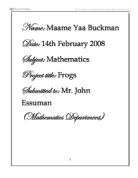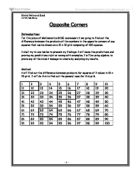Frogs Investigation - look at your results and try to find a formula which gives the least number of moves needed for any number of discs x .It may help if you can count the number of hops and slides separately .
Name: Maame Yaa Buckman Date: 14th February 2008 Subject: Mathematics Project title: Frogs Submitted to: Mr. John Essuman (Mathematics Department) Content Page Introduction to frogs Page 3 Example of the game Page 4 Question 1 Pages 5&6 Question 2 Pages 7, 8&9 Question 3 Pages 10, 11, 12&13 Formula 1 Page 14 Question 4 Page 15 Question 5 Pages 16&17 Question 6 Pages 18, 19 &20 Question 7 Pages 21, 22, 23&24 Formula Page 25 Conclusion Page 26 This was a game invented by the French mathematician called Lucas .He named it Frogs. The Aim of The Game To gain success in this interesting game you need to swap the positions of the disc so that they end up the opposite way around. (With a space in the middle) The rules are as follows: . A disc can slide over one square in either direction onto an empty square. 2. A disc can hop over one adjacent disc of the other color provided it can land on an empty square. Take a look at this example A) Slide one square to the right. B) Hops over to the left. C) Slide one square to the right.
opposite corners
Maths Coursework: Opposite Corners Opposite Corners: Introduction: My algebra coursework is about opposite corners in a square in a number grid. The top right and the bottom left numbers are multiplied and the same is done with the top left and bottom right numbers. The difference is calculated between the 2 products and the answer is used to find a pattern. The size of the square will be changed, 2x2, 3x3 and 4x4, to see whether the answers left will help to determine whether or not there is a pattern. 0x10 Grid: I am starting off by using a 10x10 and within this grid I will outline 2x2 squares, 3x3 squares and 4x4 squares. With these squares I will work out the opposite corners in order to see whether or not there is a pattern. 2 3 4 5 6 7 8 9 0 1 2 3 4 5 6 7 8 9 20 21 22 23 24 25 26 27 28 29 30 31 32 33 34 35 36 37 38 39 40 41 42 43 44 45 46 47 48 49 50 51 52 53 54 55 56 57 58 59 60 61 62 63 64 65 66 67 68 69 70 71 72 73 74 75 76 77 78 79 80 81 82 83 84 85 86 87 88 89 90 91 92 93 94 95 96 97 98 99 00 2x2 Squares: 2 3 4 5 6 7 8 9 0 1 2 3 4 5 6 7 8 9 20 21 22 23 24 25 26 27 28 29 30 31 32 33 34 35 36 37 38 39 40 41 42 43 44 45 46 47 48 49 50 51 52 53 54 55 56 57 58 59 60 61 62 63 64 65 66 67 68 69 70
OPPOSITE CORNERS
Opposite Corners Introduction: For this piece of Mathematics GCSE coursework I am going to find out the difference between the products of the numbers in the opposite corners of any squares that can be drawn on a 10 x 10 grid composing of 100 squares. I shall try to use tables to present my findings; I will make the predictions and proving my predictions right or wrong with examples. I will be using algebra to prove any of the rules I manage to create by analysing my results. Method: I will find out the difference between products for squares of 2 values in 10 x 10 grid. I will do this to find out the general case for this grid. 2 3 4 5 6 7 8 9 0 1 2 3 4 5 6 7 8 9 20 21 22 23 24 25 26 27 28 29 30 31 32 33 34 35 36 37 38 39 40 41 42 43 44 45 46 47 48 49 50 51 52 53 54 55 56 57 58 59 60 61 62 63 64 65 66 67 68 69 70 71 72 73 74 75 76 77 78 79 80 81 82 83 84 85 86 87 88 89 90 91 92 93 94 95 96 97 98 99 00 Example 1: 2 1 2 (11 x 2) - (1 x 12) = 22 - 12 = 10 Example 2: 25 26 35 36 (35 x 26) - (25 x 36) = 910 - 900 = 10 Example 3: 63 64 73 74 (73 x 64) - (63 - 74) = 4672 - 4662 = 10 So, from the above examples I can see that the difference is 10, now I will find out the general case algebraically. GENERAL CASE: n n + 1 n + 10 n + 11 (n + 10)(n





